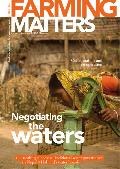Managing a scarce resource such as water requires innovative practices, and collaboration and coordination at different levels. These are some of the many interesting examples we have found from different parts of the world.
Ethiopia: More efficient laws
In spite of being a country with abundant water (including, for example, the source of the Blue Nile river), many parts of Ethiopia have regularly suffered from drought and severe famines. Nowadays, demand for water is growing at an alarming rate, responding to the needs of millions of people. As a result, water management is one of the country’s top priorities.
In recent years, the government has developed a legal framework which it hopes will improve efficiency and serve the needs of its population. This approach adopts the hydrologic boundary or “basin” as the fundamental planning unit. As a federal country, co-ordination efforts are needed between the different states, regions and central government, as well as with the local authorities.
The Ethiopian Water Resources Management Policy has been established to try to achieve this, and to involve different specialists (economists, soil scientists, hydrologists). Given that no one knows more about their own environment, this is also to include representatives of farmer organisations and villagers. More water is expected everywhere!
To find out more, contact Gebremikael Gebrehiwot, chief co-ordinator of Natural Resource Management, City Government, Addis Ababa, Ethiopia. E-mail: gmikael14@yahoo.com
Tanzania: Making irrigation more effective
When it first started working, the Traditional Irrigation and Environmental Development Organization (TIP) focused on improving the traditional irrigation systems by constructing new intakes and improving the lining of canals. But it gradually changed towards advising farmers to conserve their land. Farmers are encouraged to put into practice soil and water conservation measures such as terraces (popularly known as fanya juu), tree planting, grass tips and contour planning, and then fields are prepared to receive an increased volume of water.
TIP’s approach involves different specialists: an agronomist to train farmers in selecting seed varieties and in crop husbandry; a land use planner to recommend specific measures for particular locations, an irrigation engineer to design and supervise the construction of irrigation facilities, and a Community Development Officer to conduct awareness meetings to present and discuss the advantages of this more complete approach.
As a result, there is less erosion, and yields are higher. Small-scale farmers living on the slopes of the Pare and the Usambara mountains, in northern Tanzania, have seen their livelihoods improve.
To find out more, contact I.H. Kawa, Executive Director ,TIP, Moshi, Tanzania.
E-mail: ihkawa@yahoo.com or tip@tiptz.org
India: A simple, yet very efficient practice
When a mountain area suffers from deforestation, rainwater flows off the mountain rapidly, carrying valuable top-soil with it, causing land erosion and also devastation downstream. This is the situation in the northern Indian state of Uttarakhand, where the much-needed water is becoming increasingly scarce.
But there is a traditional practice which can still be found in the Tehri and Uttarkashi districts. It is known as kulwal, a term that describes a shallow, narrow drain that carries water from an available source (spring, fall, lake, stream, etc.) to the fields. These channels are collectively owned by the villages, which are collectively responsible for their repair and maintenance. Each village appoints a team of 2 to 12 members for one year, who are known as kulwala. It is their responsibility to ensure that water reaches all the fields equitably. This practice relieves individual families from worrying about irrigation, which can be problematic and also engender conflicts.
The villages which practise this traditional management system hardly ever report conflicts, which is remarkable given the scarcity of water. As water is becoming even more scarce, traditional practices are proving their value.
To find out more, contact Biju Negi, at the Beej Bachao Andolan (Save Seeds Movement) in Uttarakhand, India. E-mail: negi.biju@gmail.com
China: Recovering ancient waterways
The rapid industrialisation and urbanisation of China is having a serious impact on the quantity and quality of the country’s water resources. Since 2008, the World Wildlife Fund for Nature (WWF) has been running the Natural Ecosystem Rehabilitation Pilot Project, with the specific aim of “recovering” the Youzi River. This is an important source of water for the whole Chengdu region and the main waterway for Yuantian, a village in Western Sichuan.
The project works with local governments, villagers, wetland, gardening and river specialists, and local NGOs (such as the Kangmei Community Development and Marketing Service Center). To strengthen the public’s conservation awareness, the project involved many villagers, volunteers and students in dredging and widening the ancient Youzi river channels. This work helps to prevent the river being blocked by mud and garbage and prevents harmful substances from floating to the surface of the river during the rainy season.
Other activities have included establishing courtyard wetlands and building rural biogas digesters with the aim of building a regime of communal environmental management. The villagers of Yuantian are not only one of the groups of stakeholders involved, nor just beneficiaries. Having participated throughout the process, villagers are now the custodians of their river.
To find out more, contact Chen Can, Chengdu Programme, WWF Beijing Office, China. E-mail: cchen@wwfchina.org

